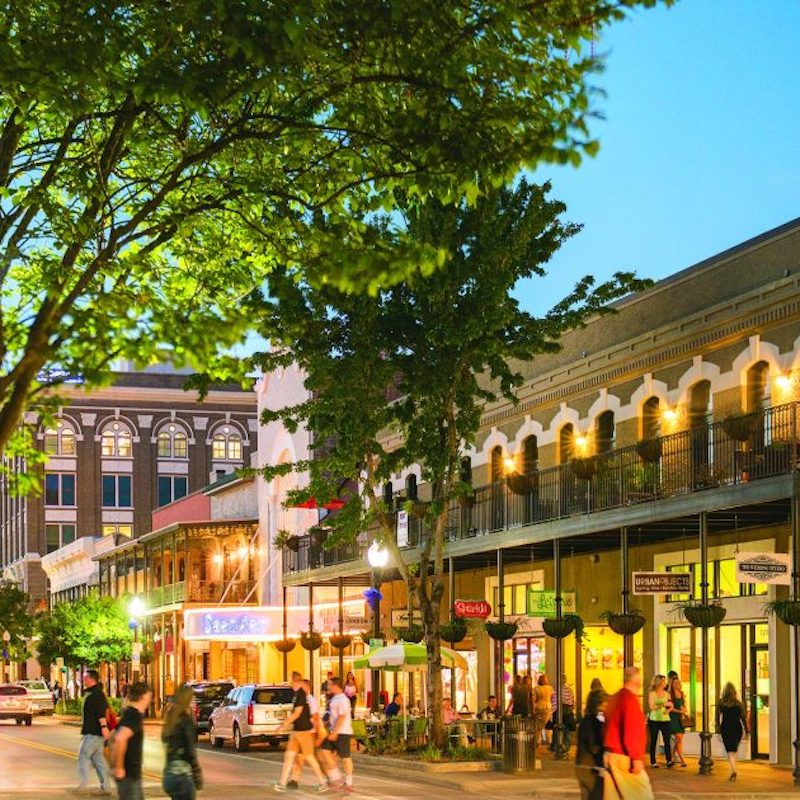
The history of the United States and Florida could have been quite different. In 1559, about 6 years before the founding of St. Augustine, Florida, a group of Spanish explorers and settlers led by explorer Tristan de Luna, dropped anchor in what would be called Pensacola Bay in an attempt to establish a colony.
Videos by TravelAwaits
Only weeks after their arrival, a terrible hurricane blew in and sunk all but three of Luna’s ships, forcing him to abandon the settlement. Historians call it the “storm that changed history” because soon after, St. Augustine was founded. The rest is, well, history. Pensacola could have been the oldest city had it not been for that unnamed storm.
Eventually, Spain would establish a settlement in what became the city of Pensacola, and over the centuries, the city has been tossed back and forth between not one but five different countries.
From its glorious early days under Spanish rule 450 years ago to its more recent naval aviation history, the history of Pensacola, Florida — the “City of Five Flags” – is deep, rich, and colorful. Let me take you to six of my favorite experiences in historic Pensacola.
1. Pensacola Archaeological Trail
As mentioned earlier, Pensacola has over 450 years of history including a rich colonial past from the 1700s.
The University of West Florida Historic Trust and Archaeological Institute, as well as the city of Pensacola, have teamed up to protect and bring the city’s colonial past back to life along this mile-long walk through Old Pensacola Village.
The trail takes visitors on a tour of the city as it was between 1752 and 1821, with stops at many historic buildings. The trail explores the foundations of the old kitchen and officer quarters built by the British during the early years of the Revolution, the remains of the British-built Fort George and the site where Andrew Jackson accepted West Florida as part of the United States in 1821.
There is no fee to walk the path which begins at the Pensacola Museum of History on South Jefferson Street. Admission to the museum is $10 for adults, $9 for seniors 65 and older, and $5 for children 3 to 13 years old. Your admission is good for 7 days and includes guided tours of the Old Pensacola Village. Tickets can be purchased online or at the door.
Parking can be tricky in the downtown area. Recommendations for parking can be found on the museum website.

2. Naval Aviation Museum
Pensacola is known as the “Cradle of Naval Aviation.” NAS Pensacola has been the starting point for the careers of all U.S. Navy aviators since it was established in 1914.
To honor this piece of the city’s history, the Navy created the Naval Aviation Museum, a 350,000-square-foot exhibit hall that houses over 4,000 aviation related artifacts and over 150 beautifully restored military aircraft and spaceflight memorabilia.
The museum features incredible interactive flight and virtual reality simulators that show you feel what it’s like to be a Navy pilot or walk on the moon with the Apollo 11 astronauts. It also features a 4K movie theater.
Normally, the museum — which is located on the NAS Pensacola base — is open to the public and is free of charge to visit. However, recent incidents on the base have caused the government to limit access to currently serving military or Department of Defense employees with ID cards. The city and the Navy are currently working on opening a separate entrance to the museum so the general public can once again enjoy this amazing museum. Keep an eye out on their website for updates.

3. Fort Pickens
For over 185 years, Fort Pickens has stood watch over Pensacola Bay and the city itself.
Following the War of 1812, during which Great Britain attempted to take control of the cities along the Gulf of Mexico by sea, the U.S. began building a series of stone forts that had 4-foot-thick, 20-foot-tall stone walls that could repel foreign invaders.
Construction on Fort Pickens began in 1829 and when finished, it was the largest of four forts built along Pensacola Bay and Santa Rosa Sound. They were built to protect the city and more importantly, the navy base.
During the Civil War, the fort was the site of the Battle of Santa Rosa Island, a fierce battle that had Confederate General Braxton Bragg saying that the artillery barrage was the “heaviest in the history of the world.” Eighty years later, the fort was put into use once again to defend the coast against potential foreign threats from the sea during World War II.
Today, the fort is part of the Gulf Islands National Seashore, a chain of barrier islands that ring the northern Gulf of Mexico from Florida to Mississippi and are managed and protected by the National Park Service.
Pickens is an impressive structure to see. Its hollow passageways echo your footsteps as you climb up on the bastions for a view of the surrounding bay and Gulf.
Besides exploring the historic fort and World War II batteries, the seashore has over 7 miles of hiking trails over dunes and sandy footpaths offering stunning views. Swim on some of the finest Gulf Coast beaches, tent, or do some RV camping.
The fort is open year-round from 8 a.m. to sunset. Admission is $25 per vehicle, which is good for 7 days of entrance to the park. You can purchase your tickets at the gate (only credit and debit cards are currently accepted) or online.

4. Fort Barrancas
Another one of the four stone forts built to protect Pensacola is Fort Barrancas. This diamond-shaped fortress (which is also part of the Gulf Islands National Seashore) has massive stone archways and impressive vaulted ceilings that are a marvel of engineering and incredible to behold. Barrancas was constructed with 6 million bricks and was designed to survive an assault from all four sides from atop its elevated perch high above the bay.
To fully appreciate the history of the fort, stop by the visitor center and join in on the next National Park Service ranger-led tour. These short walking tours are fascinating as the rangers impart a wealth of historical knowledge, especially on the tour through the passageways of the advanced redoubt.
The visitor center and fort are open daily from 9 a.m. to 4:15 p.m. The visitor center features a series of interesting exhibits that profile the history of the fort and seashore. Once again, admission is $25 per vehicle and is good for 7 days. You can purchase your tickets at the gate (only credit and debit cards are currently accepted) or online. The ranger-led tours are free.

5. Naval Live Oaks
Naval Live Oaks is one of the nation’s oldest federally protected forests. It was put under careful watch of the U.S. government in 1828 by President John Quincy Adams. It was determined the land was a strategic source of material: plentiful live oak trees that the country’s fledgling navy needed for its fleet of wooden ships.
The tall wooden ships of days gone by have long since been replaced by steel vessels but the land is still under federal protection as part of the Gulf Islands National Seashore.
The draw of Naval Live Oaks is its trails, 7.5 miles of them, over sandy footpaths through the wooded terrain. And while most of the live oaks have been destroyed by storms over the centuries, it is still a beautiful and peaceful walk, especially along the easy-walking 2.4-mile Andrew Jackson Trail. No, it wasn’t used by Jackson but it was once part of Florida’s Federal Road, the first coast-to-coast “roadway” in Florida. The hike offers splendid views of Pensacola Bay.
For nature lovers, the Brackenridge Trail is an almost mile-long, out-and-back, and ADA-accessible boardwalk lined with interpretive signage to help you identify plants. It also teaches us the military and maritime history of the area as well as providing stunning views of Santa Rosa Sound to the north.

6. Arcadia Mill Archaeological Site
A truly fascinating journey back in time is waiting for you at the Arcadia Mill Archaeological Site.
Located only 30 minutes northeast of downtown Pensacola in Milton, Arcadia was once the site for what could only be described as a multi-faceted milling operation and community that dated back to 1817.
At one time, these 42 acres was home to the largest antebellum mill on the Florida panhandle, and it wasn’t only a sawmill and lumber mill, several other side businesses also flourished here, including a shingle and textile mill and an experimental silk operation.
Start by visiting the mill’s 1,000-square-foot visitor center and museum where the story of the mill comes alive with fascinating displays and videos. The museum is open Friday and Saturday only from 10 a.m. to 4 p.m. Admission is $6 for adults, $5 for seniors 65 and older, and $3 for children ages 3 to 14. Children under 3 years old are free.
Once you get a feel for the history, see it firsthand as you stroll down the ADA-accessible boardwalk. This 0.75-mile walk takes you through the beautiful forest and wetlands where you not only learn about nature and take in wildlife, but also see the remains of the industry that was once here. The boardwalk is free to explore.
Wrap up your visit with a stop at the Arcadia Homestead, a museum that uses multi-sensory exhibits to recreate life on the Arcadia Farm during the Great Depression. The homestead is located next to the mill’s visitor center and admission is included with your ticket to Arcadia Mill.

